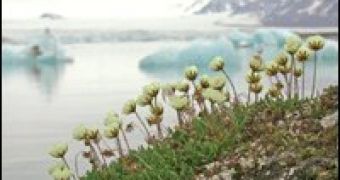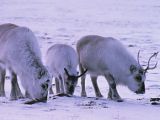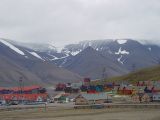Humans conquered the entire Globe, but to the poles, the climate is too harsh to sustain human populations. So, a question rises: till which latitude can humans live?
Well, it appears that the northernmost inhabited land is not Greenland, but the Svalbard archipelago, located north off Norway. Svalbard is made of 5 big islands, and various islets, located between 74 and 81o N and which 8-9 months per year (at least, they used to do so, as only in the 20th century the Svalbard climate warmed up by 6? C) are encased in ice.
What makes this land the northernmost inhabited one are the warmer waters of the Gulf Stream, which free for a few months annually this land from the ice belt and make the clime much milder than in other areas located at the same altitude.
The Svalbard have a surface of 62,422 square km (a little less than Scotland) and were found in 1596 by the Dutch explorer Wilhelm Barents while searching a northern sea path to China. The Dutch baptized them Spitsbergen ("steep mountains"). Later, Norwegians called them Svalbard ("cold coast"), claiming that Vikings were the first to step the islands, according to the 1196 Iceland annals. Now, the name Spitsbergen is used for the largest island.
In the 17th century, Englishmen condemned to death penalty could save themselves by colonizing Svalbard. During all that time, the archipelago was visited by the whalers, seal hunters, trappers (hunting for fur animals: polar foxes) and many explorers, that used it as a springboard to the North Pole. In 1926, Amundsen started from Svalbard in his transpolar route to the Alaska.
From 1925, the archipelago belongs to Norway.
The northernmost island was named by the Dutch whalers Amsterdam and founded there a whale oil processing settlement, called "the City of the Blubber". But in the 18th century, rich stores of carbon (up to 5 m (15 ft) thick) and copper ore were found in Svalbard.
Svalbard has a lot of fjords and its mountains can be 1,500 m (5,000 ft) tall. Lakes and glaciers abound on the islands; in fact, glaciers cover 60 % of the archipelago.
In some places, there are stripes of tundra, in which the tallest "trees" are dwarf willows, not taller than 5 cm (2 inch). The snow falls 100 days per year and the soil is covered by snow 8 months annually. The soil is frozen (permafrost) and only the upper layer melts for a few months yearly.
Surprisingly, there are 170 flowering plant species in Svalbard, like the yellow arctic poppy (Papaver dahlianum, Svalbard's national flower), rhododendrons, arctic bell heathers (Cassiope tetragona), with white flowers forming carpets under the snow on the ridges (this plant was used as fuel by Eskimoes) and mountain avens (Dryas octopetala), growing on moraine ridges (deposits of rocks and sand edging a glacier). Svalbard has fields of purple saxifrage (Saxifraga oppositifolia), which flourishes at the beginning of June and grows up to altitudes of 1,000 m (3,330 ft). This plant grows in north Greenland, at 83?15'N, the most northerly plant locality in the world. Polar willows (Salix polaris) forms carpets in the areas more exposed to the sun. On swamps, large moss carpets and white cottongrass (Eriophorum scheuchzeri) grow. On some areas grows the wood sorrel (Oxyria digyna), which can be 10-20 cm (4-8 in) tall. This plant is effective against scurvy. Mosses and scarlet likens grow up to altitudes of 1,000 m (3,330 ft).
Despite the latitude, Svalbard has a rich fauna: dwarf reindeer (a subspecies endemic to Svalbard), (introduced) musk oxen, polar foxes, seals, walruses, whales and 28 species of birds, but the most famous inhabitants of Svalbard are the polar bears. Arctic foxes eat birds, chicks and eggs, but also carrion, especially left by the polar bears. The foxes and the reindeer are Svalbard's only local land mammals.
Contamination and global warming are a great threat for the polar bears, even if it hunting them has been forbidden in Svalbard since 1973. The bears tend to accumulate to contaminants (like PCBs), as they are at the end of the food chain.
Amongst the bird species, only the ptarmigan is sedentary, the rest are migratory and mainly sea birds, like guillemots, razorbills, auks, gulls, terns and sandpipers. The arctic tern will migrate during the winter to Antarctica!
During the summer, many icebergs take off from Svalbard. Such a giant can be 30 m (100 ft) tall and detach from a 15 km (9 mi) front, producing at its collapse on the sea a noise which can be heard on a distance of 50 km (30 mi).
Spitsbergen is the only inhabited island, with just four permanent settlements.
At the archipelago's capital, Longyearbyean, the sun never sets between 20 of April and 20 of August (ceaselessly for 3,000 hours) while from 23 of October till 19 of February, there is a continuous darkness. When the ice belt around Svalbard is formed, sea communication is interrupted, remaining only that by plane.
The name of the 2,000 inhabitants capital, located at 78? N, comes from John Longyear, an American magnate, who opened the first carbon mine in 1906. This is the largest locality in Svalbard. Since 1975, there is an airport whose runway functions all the year round.
This locality is fully modern, with supermarket, post, bank, public library, schools, children gardens, hotels, bars, restaurants, hospital and even a local newspaper.
The main occupation of the Svalbard's inhabitants is mining (mainly carbon), tourism industry and fishing.
Ny-?lesund ("New ?lesund") at 78?55′N, 11?56′E is the world's northernmost functional public settlement, with a permanent population of about 35 persons. All of them are working for one of the research stations - the Global Atmosphere Watch has one here - or the logistics and supply company "Kings Bay", which runs the research village. In the summer, 120 researchers, technicians and field assistants come here, from Norway, The Netherlands, Germany, UK, France, Italy, Japan, South Korea and China.
In 2006, 28 fossil skeletons of plesiosaurs and ichthyosaurs, huge marine reptiles from the Dinosaur Age, were found in Svalbard. Petrol has been connected to these fossils.
Fossil trees found on Svalbard show that once the archipelago's climate was temperate and even tropical, which broad leaved and coniferous trees. Dinosaurs, too, more than 65 million years ago, roamed Svalbard.
Even today, Svalbard moves towards north by several centimeters per year; once it was located close to the Equator.

 14 DAY TRIAL //
14 DAY TRIAL // 

